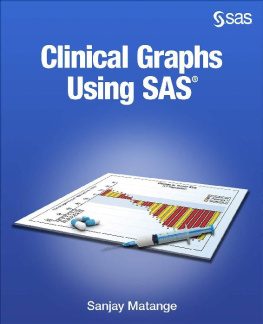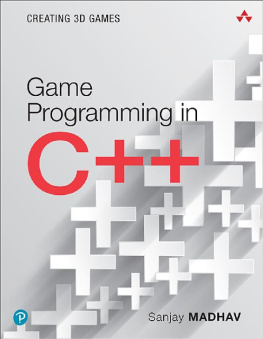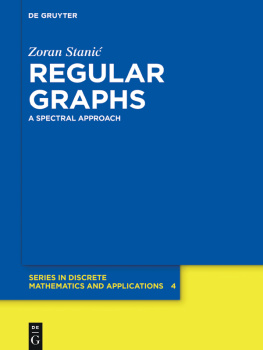Sanjay Matange - Clinical Graphs Using SAS
Here you can read online Sanjay Matange - Clinical Graphs Using SAS full text of the book (entire story) in english for free. Download pdf and epub, get meaning, cover and reviews about this ebook. year: 2016, publisher: SAS Institute, genre: Computer. Description of the work, (preface) as well as reviews are available. Best literature library LitArk.com created for fans of good reading and offers a wide selection of genres:
Romance novel
Science fiction
Adventure
Detective
Science
History
Home and family
Prose
Art
Politics
Computer
Non-fiction
Religion
Business
Children
Humor
Choose a favorite category and find really read worthwhile books. Enjoy immersion in the world of imagination, feel the emotions of the characters or learn something new for yourself, make an fascinating discovery.
- Book:Clinical Graphs Using SAS
- Author:
- Publisher:SAS Institute
- Genre:
- Year:2016
- Rating:3 / 5
- Favourites:Add to favourites
- Your mark:
- 60
- 1
- 2
- 3
- 4
- 5
Clinical Graphs Using SAS: summary, description and annotation
We offer to read an annotation, description, summary or preface (depends on what the author of the book "Clinical Graphs Using SAS" wrote himself). If you haven't found the necessary information about the book — write in the comments, we will try to find it.
Clinical Graphs Using SAS — read online for free the complete book (whole text) full work
Below is the text of the book, divided by pages. System saving the place of the last page read, allows you to conveniently read the book "Clinical Graphs Using SAS" online for free, without having to search again every time where you left off. Put a bookmark, and you can go to the page where you finished reading at any time.
Font size:
Interval:
Bookmark:
Sanjay Matange
 support.sas.com/bookstore
support.sas.com/bookstore
The correct bibliographic citation for this manual is as follows: Matange, Sanjay. 2016. Clinical Graphs Using SAS. Cary, NC: SAS Institute Inc.
Clinical Graphs Using SAS
Copyright 2016, SAS Institute Inc., Cary, NC, USA
ISBN 978-1-62959-701-0 (Hard copy)
ISBN 978-1-62960-205-9 (EPUB)
ISBN 978-1-62960-206-6 (MOBI)
ISBN 978-1-62960-207-3 (PDF)
All Rights Reserved. Produced in the United States of America.
For a hard copy book: No part of this publication may be reproduced, stored in a retrieval system, or transmitted, in any form or by any means, electronic, mechanical, photocopying, or otherwise, without the prior written permission of the publisher, SAS Institute Inc.
For a web download or e-book: Your use of this publication shall be governed by the terms established by the vendor at the time you acquire this publication.
The scanning, uploading, and distribution of this book via the Internet or any other means without the permission of the publisher is illegal and punishable by law. Please purchase only authorized electronic editions and do not participate in or encourage electronic piracy of copyrighted materials. Your support of others rights is appreciated.
U.S. Government License Rights; Restricted Rights: The Software and its documentation is commercial computer software developed at private expense and is provided with RESTRICTED RIGHTS to the United States Government. Use, duplication, or disclosure of the Software by the United States Government is subject to the license terms of this Agreement pursuant to, as applicable, FAR 12.212, DFAR 227.7202-1(a), DFAR 227.7202-3(a), and DFAR 227.7202-4, and, to the extent required under U.S. federal law, the minimum restricted rights as set out in FAR 52.227-19 (DEC 2007). If FAR 52.227-19 is applicable, this provision serves as notice under clause (c) thereof and no other notice is required to be affixed to the Software or documentation. The Governments rights in Software and documentation shall be only those set forth in this Agreement.
SAS Institute Inc., SAS Campus Drive, Cary, NC 27513-2414
March 2016
SAS and all other SAS Institute Inc. product or service names are registered trademarks or trademarks of SAS Institute Inc. in the USA and other countries. indicates USA registration.
Other brand and product names are trademarks of their respective companies.
SAS software may be provided with certain third-party software, including but not limited to open-source software, which is licensed under its applicable third-party software license agreement. For license information about third-party software distributed with SAS software, refer to http://support.sas.com/thirdpartylicenses.
SAS users in the Health and Life Sciences industry need to create complex graphs so that biostatisticians and clinicians can use them for analysis of the data. The graphs are also used for submissions to FDA for drug approvals. These graphs have specific requirements and must be designed to deliver the data accurately and clearly without distractions. Many users do not have the skills with SAS graphics tools such as Statistical Graphics (SG) procedures and the Graph Template Language (GTL) to create such graphs. This book provides the know-how and the code to create the graphs that are commonly used in this industry.
This book is for the SAS graphics programmer who is responsible for creating sophisticated graphs for the analysis of clinical trials data. Most of these graphs are not automatically created by some analytical procedure, and must be custom built. However, many of these graphs are commonly used in the Health and Life Sciences industry, and there is an effort in the industry to standardize. This book describes how to create such graphs for intermediate and advanced graph programmers.
Some knowledge of SAS DATA step programming may be required to get the data into the shape needed for the graphs. Knowledge of SG procedures and GTL will be helpful, but is not required.
This book includes detailed instructions about how to create some of the standard, commonly used graphs for analysis of data in the Health and Life Sciences industry. The book provides some introductory information on the use of SG procedures and GTL.
However, this book does not cover the features of SG procedures or of GTL in depth. Such comprehensive information is beyond the scope of this book.
All the graphs shown in this book are generated using SAS 9.4 or SAS 9.3.
To access the books example code and data, visit the authors page at http://support.sas.com/publishing/authors. Select the name of the author. Then, look for the book cover and select Example Code and Data.
If you are unable to access the code through the website, send email to .
If you are using SAS University Edition to access data and run your programs, ensure that the software contains the product or products that you need to run the code: http://support.sas.com/software/products/university-edition/index.html.
All the graphs included in the book are created using the program code shown in the chapters. Some appearance options in the code might have been trimmed to fit the space available on the page. The full programs including the data generation and procedure code are available.
Although this book illustrates many analyses regularly performed in businesses across industries, questions specific to your aims and issues may arise. To fully support you, SAS Institute and SAS Press offer you the following help resources:
For questions about topics covered in this book, contact the author through SAS Press:
Send questions by email to ; include the book title in your correspondence.
Submit feedback on the authors page at http://support.sas.com/author_feedback.
For questions about topics in or beyond the scope of this book, post queries to the relevant SAS Support Communities at https://communities.sas.com/welcome.
SAS Institute maintains a comprehensive website with up-to-date information. One page that is particularly useful to both the novice and the seasoned SAS user is the Knowledge Base. Search for relevant notes in the Samples and SAS Notes section of the Knowledge Base at http://support.sas.com/resources.
Registered SAS users or their organizations can access SAS Customer Support at http://support.sas.com. Here you can pose specific questions to SAS Customer Support; under Support, click Submit a Problem. You will need to provide an email address to which replies can be sent, identify your organization, and provide a customer site number or license information. This information can be found in your SAS logs.
We look forward to hearing from you. We invite questions, comments, and concerns. If you want to contact us about a specific book, please include the book title in your correspondence.
Visit the authors page at http://support.sas.com/author_feedback.
Send comments by email to
Font size:
Interval:
Bookmark:
Similar books «Clinical Graphs Using SAS»
Look at similar books to Clinical Graphs Using SAS. We have selected literature similar in name and meaning in the hope of providing readers with more options to find new, interesting, not yet read works.
Discussion, reviews of the book Clinical Graphs Using SAS and just readers' own opinions. Leave your comments, write what you think about the work, its meaning or the main characters. Specify what exactly you liked and what you didn't like, and why you think so.











